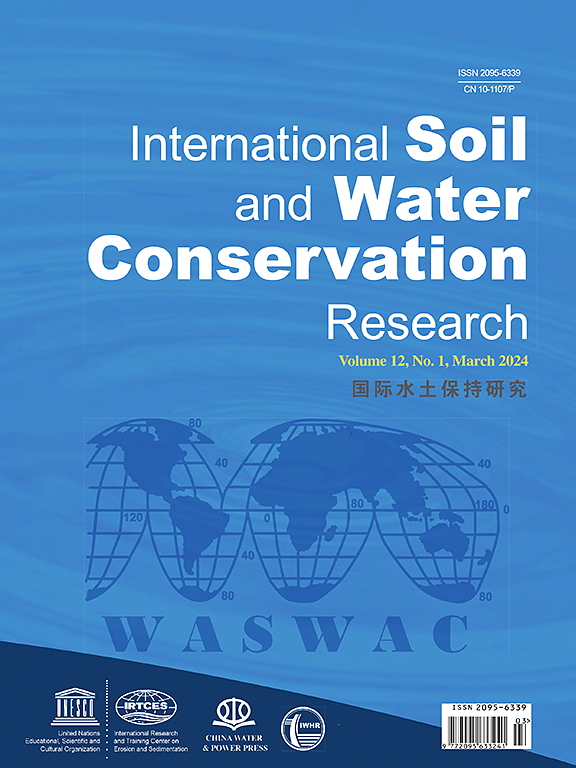Heavy metal(loid)s migration mechanisms during soil erosion: A systematic quantitative review
IF 7.3
1区 农林科学
Q1 ENVIRONMENTAL SCIENCES
International Soil and Water Conservation Research
Pub Date : 2025-02-19
DOI:10.1016/j.iswcr.2025.02.002
引用次数: 0
Abstract
Heavy metal(loid)s migration occurs in both particulate and dissolved forms during soil erosion, but it is unclear which form is dominant and which factors affect it. Thus, a quantitative synthesis of 379 global observations was conducted to assess heavy metal(loid)s migration mechanisms and a random forest analysis was used to assess the influence of key factors on the dissolved fraction of heavy metal(loid)s. Particulate-associated heavy metal(loid)s transport accounts for over 80% of the total. Heavy metal(loid)s migration forms are not significantly affected by experimental conditions (indoor simulated and field monitored), yet they vary between erosional and depositional zones. The dissolved percentage of Pb, As and Hg within areas of erosion were higher than in areas of deposition, while the opposite trend occurred for Cd, Cu, Zn, Cr and Ni. Soil Total Organic Carbon (TOC) was the most important factor affecting the migration of heavy metal(loid)s during soil erosion. Our results confirmed that heavy metal(loid)s usually migrate in association with fine-grained sediments due to their large surface area and high surface functional groups. These findings provide scientific guidance for further understanding migration mechanisms and the methods need to control heavy metal(loid)s transport during soil erosion.
土壤侵蚀过程中重金属迁移机制的系统定量研究
在土壤侵蚀过程中,重金属以颗粒和溶解两种形式迁移,但目前尚不清楚哪一种形式占主导地位以及哪些因素影响重金属迁移。为此,通过对379个全球观测数据的定量综合来评估重金属(loid)的迁移机制,并采用随机森林分析来评估关键因素对重金属(loid)溶解分数的影响。与颗粒物相关的重金属(loid)的运输占总量的80%以上。实验条件(室内模拟和现场监测)对重金属迁移形态没有显著影响,但在侵蚀带和沉积带之间存在差异。侵蚀区Pb、As和Hg的溶解率高于沉积区,Cd、Cu、Zn、Cr和Ni的溶解率则相反。土壤总有机碳(TOC)是影响土壤侵蚀过程中重金属迁移的最重要因素。我们的研究结果证实,重金属(样物质)由于其大表面积和高表面官能团,通常与细粒沉积物一起迁移。这些发现为进一步认识土壤侵蚀过程中重金属迁移机制和控制重金属迁移的方法提供了科学指导。
本文章由计算机程序翻译,如有差异,请以英文原文为准。
求助全文
约1分钟内获得全文
求助全文
来源期刊

International Soil and Water Conservation Research
Agricultural and Biological Sciences-Agronomy and Crop Science
CiteScore
12.00
自引率
3.10%
发文量
171
审稿时长
49 days
期刊介绍:
The International Soil and Water Conservation Research (ISWCR), the official journal of World Association of Soil and Water Conservation (WASWAC) http://www.waswac.org, is a multidisciplinary journal of soil and water conservation research, practice, policy, and perspectives. It aims to disseminate new knowledge and promote the practice of soil and water conservation.
The scope of International Soil and Water Conservation Research includes research, strategies, and technologies for prediction, prevention, and protection of soil and water resources. It deals with identification, characterization, and modeling; dynamic monitoring and evaluation; assessment and management of conservation practice and creation and implementation of quality standards.
Examples of appropriate topical areas include (but are not limited to):
• Conservation models, tools, and technologies
• Conservation agricultural
• Soil health resources, indicators, assessment, and management
• Land degradation
• Sustainable development
• Soil erosion and its control
• Soil erosion processes
• Water resources assessment and management
• Watershed management
• Soil erosion models
• Literature review on topics related soil and water conservation research
 求助内容:
求助内容: 应助结果提醒方式:
应助结果提醒方式:


